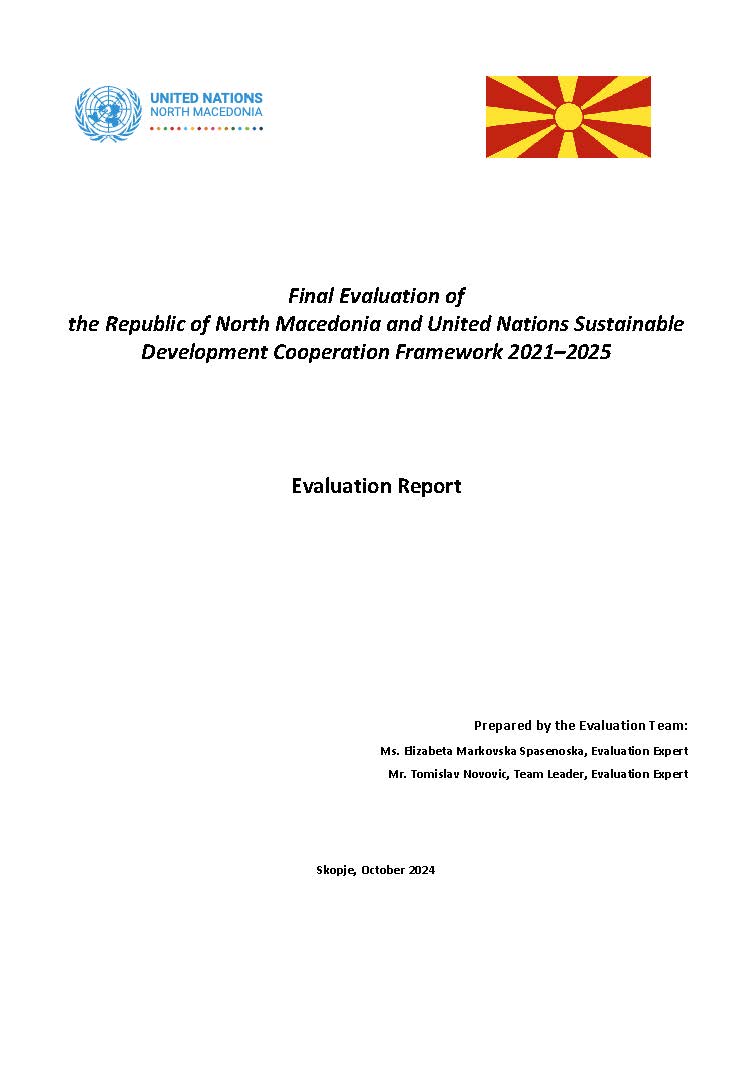
UNSDCF 2021-2025 Joint evaluation
Output 1.1 The 2030 Agenda, Paris Agreement and other intergovernmentally-agreed frameworks integrated in national and local development plans, measures to accelerate progress put in place, and budgets and progress assessed using data-driven solutions
Output 1.2 Social protection services and systems strengthened across sectors with increased investment
Output 1.3 Access to basic services and financial and non-financial assets and services improved to support productive capacities for sustainable livelihoods and jobs to achieve prosperity
Output 1.4 Equitable, resilient and sustainable systems for health and pandemic preparedness strengthened to address communicable and non-communicable diseases, including COVID-19, HIV, tuberculosis, malaria and mental health
Output 2.1 Open, agile, accountable and future-ready governance systems in place to co-create and deliver solutions to accelerate SDG achievement
Output 2.2 Civic space and access to justice expanded, racism and discrimination addressed, and rule of law, human rights and equity strengthened
Output 2.3 Responsive governance systems and local governance strengthened for socio economic opportunity, inclusive basic service delivery, community security, and peacebuilding
Output 2.4 Democratic institutions and processes strengthened for an inclusive and open public sphere with expanded public engagement
Output 3.1 Institutional systems to manage multi-dimensional risks and shocks strengthened at regional, national and sub-national levels
Output 3.2 Capacities for conflict prevention and peacebuilding strengthened at regional, national and sub-national levels and across borders
Output 3.3 Risk informed and gender-responsive recovery solutions, including stabilization efforts and mine action, implemented at regional, national and sub-national levels
Output 3.4 Integrated development solutions implemented to address the drivers of irregular and forced migration, enhance the resilience of migrants, forcibly displaced and host communities, and expand the benefits of human mobility
Output 4.1 Natural resources protected and managed to enhance sustainable productivity and livelihoods
Output 4.2 Public and private investment mechanisms mobilized for biodiversity, water, oceans, and?climate solutions
Output 5.1 Energy gap closed
Output 5.2 Transition to renewable energy accelerated capitalizing on technological gains, clean energy innovations and new financing mechanisms to support green recovery
Output 6.1 Country-led measures implemented to achieve inclusive economies and to advance economic empowerment of women in all their diversity, including in crisis contexts
Output 6.2 Women’s leadership and participation advanced through implementing affirmative measures, strengthening institutions and civil society, and addressing structural barriers, in order to advance gender equality, including in crisis contexts
Output 6.3 National capacities to prevent and respond to gender-based violence (GBV) and address harmful gender social norms strengthened, including in crisis contexts
Output E.1 People and institutions equipped with strengthened digital capabilities and opportunities to contribute to and benefit from inclusive digital societies
Output E.2 Innovation capabilities built, and approaches adopted to expand policy options at global, regional, national and sub-national levels
Output E.3 Public and private financing for the achievement of the SDGs expanded at global, regional, and national levels
Goal 2. End hunger, achieve food security and improved nutrition and promote sustainable agriculture
Goal 3. Ensure healthy lives and promote well-being for all at all ages
Goal 4. Ensure inclusive and equitable quality education and promote lifelong learning opportunities for all
Goal 5. Achieve gender equality and empower all women and girls
Goal 8. Promote sustained, inclusive and sustainable economic growth, full and productive employment and decent work for all
Goal 10. Reduce inequality within and among countries
Goal 11. Make cities and human settlements inclusive, safe, resilient and sustainable
Goal 12. Ensure sustainable consumption and production patterns
Goal 13. Take urgent action to combat climate change and its impacts
Goal 15. Protect, restore and promote sustainable use of terrestrial ecosystems, sustainably manage forests, combat desertification, and halt and reverse land degradation and halt biodiversity loss
2.2 By 2030, end all forms of malnutrition, including achieving, by 2025, the internationally agreed targets on stunting and wasting in children under 5 years of age, and address the nutritional needs of adolescent girls, pregnant and lactating women and older persons
2.4 By 2030, ensure sustainable food production systems and implement resilient agricultural practices that increase productivity and production, that help maintain ecosystems, that strengthen capacity for adaptation to climate change, extreme weather, drought, flooding and other disasters and that progressively improve land and soil quality
3.1 By 2030, reduce the global maternal mortality ratio to less than 70 per 100,000 live births
3.2 By 2030, end preventable deaths of newborns and children under 5 years of age, with all countries aiming to reduce neonatal mortality to at least as low as 12 per 1,000 live births and under-5 mortality to at least as low as 25 per 1,000 live births
3.4 By 2030, reduce by one third premature mortality from non-communicable diseases through prevention and treatment and promote mental health and well-being
3.7 By 2030, ensure universal access to sexual and reproductive health-care services, including for family planning, information and education, and the integration of reproductive health into national strategies and programmes
3.8 Achieve universal health coverage, including financial risk protection, access to quality essential health-care services and access to safe, effective, quality and affordable essential medicines and vaccines for all
3.d Strengthen the capacity of all countries, in particular developing countries, for early warning, risk reduction and management of national and global health risks
4.1 By 2030, ensure that all girls and boys complete free, equitable and quality primary and secondary education leading to relevant and effective learning outcomes
4.2 By 2030, ensure that all girls and boys have access to quality early childhood development, care and pre-primary education so that they are ready for primary education
4.4 By 2030, substantially increase the number of youth and adults who have relevant skills, including technical and vocational skills, for employment, decent jobs and entrepreneurship
4.5 By 2030, eliminate gender disparities in education and ensure equal access to all levels of education and vocational training for the vulnerable, including persons with disabilities, indigenous peoples and children in vulnerable situations
5.1 End all forms of discrimination against all women and girls everywhere
5.2 Eliminate all forms of violence against all women and girls in the public and private spheres, including trafficking and sexual and other types of exploitation
5.6 Ensure universal access to sexual and reproductive health and reproductive rights as agreed in accordance with the Programme of Action of the International Conference on Population and Development and the Beijing Platform for Action and the outcome documents of their review conferences
8.2 Achieve higher levels of economic productivity through diversification, technological upgrading and innovation, including through a focus on high-value added and labour-intensive sectors
8.3 Promote development-oriented policies that support productive activities, decent job creation, entrepreneurship, creativity and innovation, and encourage the formalization and growth of micro-, small- and medium-sized enterprises, including through access to financial services
8.4 Improve progressively, through 2030, global resource efficiency in consumption and production and endeavour to decouple economic growth from environmental degradation, in accordance with the 10-Year Framework of Programmes on Sustainable Consumption and Production, with developed countries taking the lead
8.5 By 2030, achieve full and productive employment and decent work for all women and men, including for young people and persons with disabilities, and equal pay for work of equal value
8.6 By 2020, substantially reduce the proportion of youth not in employment, education or training
10.7 Facilitate orderly, safe, regular and responsible migration and mobility of people, including through the implementation of planned and well-managed migration policies
11.6 By 2030, reduce the adverse per capita environmental impact of cities, including by paying special attention to air quality and municipal and other waste management
12.2 By 2030, achieve the sustainable management and efficient use of natural resources
12.4 By 2020, achieve the environmentally sound management of chemicals and all wastes throughout their life cycle, in accordance with agreed international frameworks, and significantly reduce their release to air, water and soil in order to minimize their adverse impacts on human health and the environment
13.1 Strengthen resilience and adaptive capacity to climate-related hazards and natural disasters in all countries
15.1 By 2020, ensure the conservation, restoration and sustainable use of terrestrial and inland freshwater ecosystems and their services, in particular forests, wetlands, mountains and drylands, in line with obligations under international agreements



Outcome 3 is missing and cannot be selected:
"UNSDCF – Outcome 3
By 2025, people in North Macedonia benefit from ambitious climate action, sustainably managed natural resources and well-preserved biodiversity through good environmental governance and disaster resilient communities"